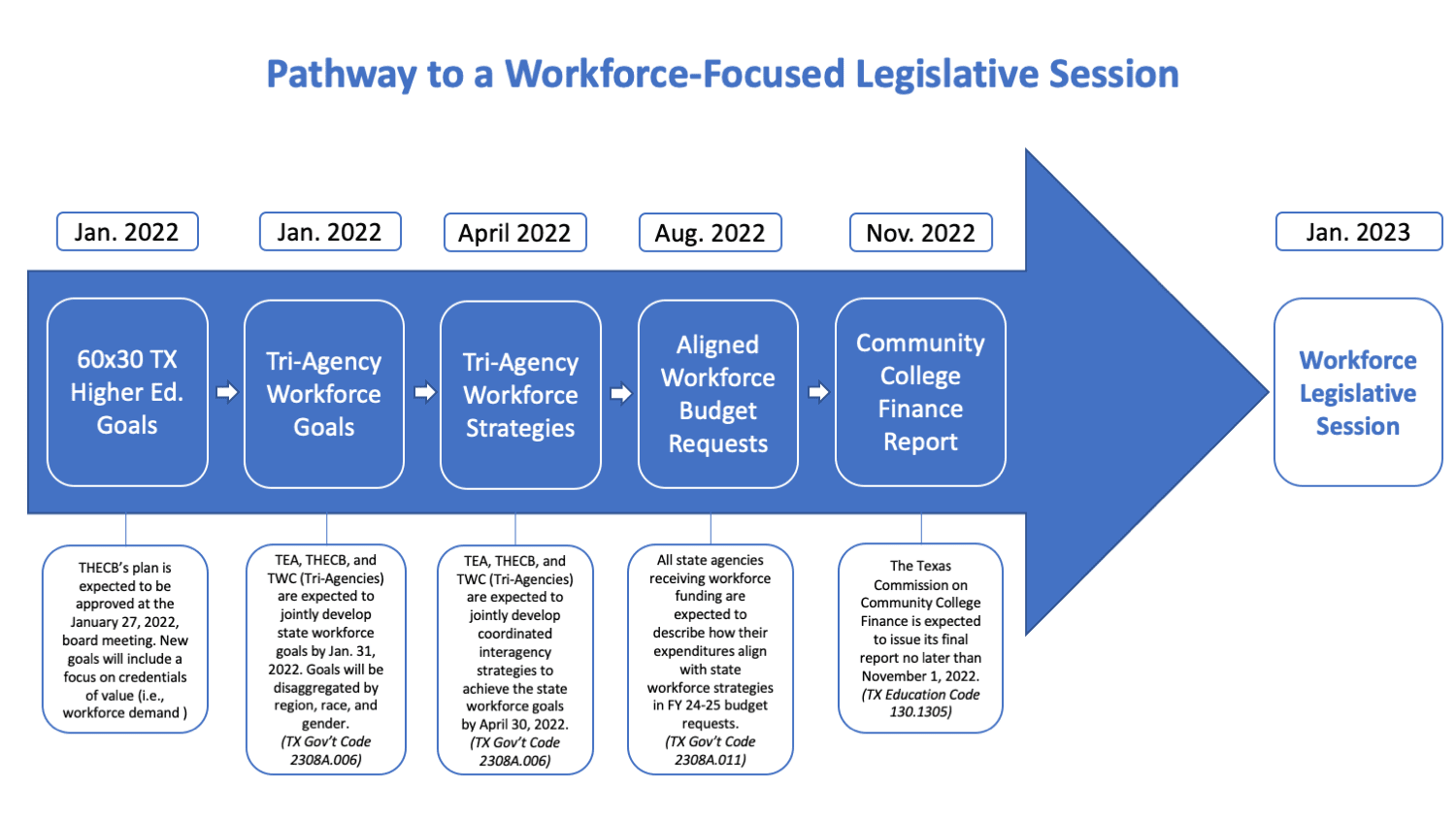The Texas Commission on Community College Finance (TXCCCF) met last week to learn and discuss the topic of workforce and how it relates to Texas community colleges.
Dr. Anthony Carnevale, Director & Research Professor at The Georgetown University Center on Education and the Workforce, captured the tone of the meeting in a single quip: “Education policy is jobs policy.” We agree.
To ensure that Texans are well-equipped for the job markets of the future, it is critical that we continue to synchronize the state’s education and workforce systems. Two themes arose from the TXCCCF meeting that could begin the alignment in the community college sphere: connecting postsecondary education with workforce outcomes and ensuring workforce alignment in community college financing systems.
Postsecondary Education & Workforce Outcomes
Postsecondary education is increasingly a gateway to gainful employment. By 2036, 71% of all available jobs will require some type of postsecondary credential. However, access to jobs is not the only important postsecondary education outcome to consider – earning potential also matters.
Dr. Carnevale stated that, out of the total “good jobs” (defined as a job with a $45,000 annual wage by age 40) in Texas in 2019, only 212,000 jobs were available to Texans without a high school diploma. By contrast, 987,000 jobs were available to Texans with some college but no degree, which includes graduates with certificates, while 3.1 million jobs were available for graduates with a bachelor’s degree or higher. Clear linkages between available jobs, earning potential, and associated levels of education can assist the state in identifying and attaining desired outcomes.
This information is also important to students. Dr. David Troutman, Chief Data Officer & Associate Vice Chancellor for Institutional Research for The University of Texas System, contributed to the Postsecondary Value Commission’s research, which attempted to define the “value” of a postsecondary credential for various students including whether a credential provides a graduate with earnings high enough to pay off their cost of attendance within ten years, or whether they are able to obtain median earnings equal to their peers statewide.
This example of transparent and publicly-available information on workforce outcomes can help students and their families make informed decisions about which education-to-workforce pathway to pursue. This is also particularly helpful for students who are at risk of dropping out before they complete their credentials, preventing the waste of both public and personal resources.
Workforce Alignment in Community College Finance Systems

Martha Snyder, Senior Director at HCM Strategists, highlighted common characteristics of strong community college finance systems including alignment with a state’s current workforce needs. With its diverse economy and sheer size, this is a tall order for Texas, but it’s certainly not impossible.
The National Center for Higher Education Management Systems recommended that the TXCCCF align the Texas community college finance system to regional workforce needs to account for the state’s manifold business industries. Fortunately, there are existing, data-driven resources that can be leveraged for this purpose, such as the work of the state’s 28 local workforce boards to individually determine the industries and occupations that are most important to their respective communities.
Texas’ community college finance system should also be responsive to the unique needs of the pandemic-era workforce. In the latter half of 2021, Texas had more people leaving their jobs than any other state. However, they’re staying in the job market, only leaving their jobs to pursue better opportunities. Community colleges can provide these Texans with the education and training they need to reskill or upskill for better jobs.
Dane Linn, Senior Vice President of Corporate Initiatives and Immigration with Business Roundtable, noted that reskilling and upskilling present more accessible and affordable education opportunities, particularly for adult learners who need to balance their education with simultaneously providing for their families. Employers would also benefit by having high-quality, rigorous educational options for existing employees who could move up to more skill-intensive, positions.

Importantly, workforce alignment in postsecondary education has proven champions in Texas. Michael Reeser, Chancellor & CEO of Texas State Technical College (TSTC), testified to the TXCCCF about how the state’s only technical college system and its graduates have benefited from tailoring its educational offerings to workforce needs.
While TSTC’s total enrollment statewide has remained relatively constant since 2009, their graduate count has increased 71% and graduates’ salaries have increased 143%. TSTC credits this success largely to the state’s revision of the technical college finance system, which now incentivizes progress in students’ job earnings. This is evidence that workforce alignment in financing systems can help improve student outcomes..
The Path Forward

Throughout 2022, Texas has major opportunities to better align its educational and workforce systems. HB 3767, passed last session, brings together multiple efforts, including the TXCCCF, into a streamlined workforce timeline. For the first time in Texas’ history, state leaders will set statewide workforce development goals and strategies. The state will also be required to strategically target its career education and training financial resources towards investments that will advance those goals and strategies.
This alignment process will begin at the end of this month, building on the strong work done by the THECB in reforming the state’s long-range higher education strategic plan, 60x30TX, with an updated version of the plan, named Building a Talent Strong Texas. THECB Commissioner Harrison Keller highlighted tenets of this effort, and the state is already committed to delivering better workforce outcomes for Texans through its initiative to promote credentials of value. These credentials will have proven wage outcomes for its graduates, which help ensure that Texas postsecondary students have a pathway to an in-demand, good-paying job.
Texas 2036 will be engaged throughout the year to support the state in this historic work. Through data-driven solutions and joint action, we can sustain the “Texas Miracle” and guarantee that our state remains the best place to live and work for generations to come.
You can watch a recording of the TXCCCF’s meeting here.
